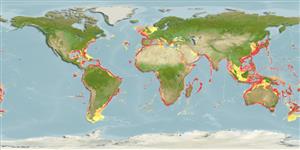Lớp phụ Cá sụn (cá mập và cá đuối) (sharks and rays) >
Hexanchiformes (Frill and cow sharks) >
Hexanchidae (Cow sharks)
Etymology: Heptranchias: hept[a] (Gr.), seven; ranchias, etymology unclear, possibly a variant spelling of anchos (Gr.), gill, possibly with the addition of -ias, borrowed from karkharías, ancient Greek for shark (cf. Carcharias Rafinesque 1810), referring to how the seven gill openings extend down onto the throat (See ETYFish); perlo: From the French vernacular “Le Perlon,” pearl, probably referring to its smooth and grayish (“lisse & grisâtre”) skin (See ETYFish).
More on author: Bonnaterre.
Environment: milieu / climate zone / depth range / distribution range
Sinh thái học
Biển Tầng đáy biển sâu; Mức độ sâu 0 - 1000 m (Ref. 41394), usually 180 - 450 m (Ref. 45445). Deep-water; 58°N - 58°S, 98°W - 173°W
Circumglobal in tropical and temperate seas, excluding the northeast Pacific (Ref. 13573). Western Atlantic: North Carolina, USA and northern Gulf of Mexico to Cuba, then from Venezuela to Argentina (Ref. 6871). Eastern Atlantic: Morocco to Namibia, including the Mediterranean Sea (Ref. 247). Indian Ocean: southwestern India, Aldabra Island, southern Mozambique, and South Africa (Ref. 247). Western Pacific: Japan to China, Indonesia, Australia and New Zealand. Southeast Pacific: off northern Chile (Ref. 247).
Length at first maturity / Bộ gần gũi / Khối lượng (Trọng lượng) / Age
Maturity: Lm 87.7, range 75 - 98 cm
Max length : 137 cm TL con đực/không giới tính; (Ref. 247); 140.0 cm TL (female); common length : 100.0 cm TL con đực/không giới tính; (Ref. 26999)
Các tia vây lưng cứng (tổng cộng) : 0; Tia cứng vây hậu môn: 0; Động vật có xương sống: 125 - 161. A narrow-headed, big-eyed small seven-gilled shark (Ref. 247). Body fusiform and slender; dorsal fin small, originating over inner margins of pelvic fins; anal fin small (Ref. 6871). Teeth wide, low and comb-shaped (Ref. 6871). Brownish grey above, paler below, sometimes with indistinct dark blotches on body; juveniles with dark-tipped dorsal and caudal fins, adults with light fin margins (Ref. 5578, 6574, 6871). Live specimens with fluorescent green eyes (Ref. 6871).
Found on the outer continental and insular shelves and upper slopes in depths of 100 to 400 (Ref. 13573, 11230), also inshore and down to 1,000 m (Ref. 6871, 11230). Feeds on small sharks and rays, small bony fish, shrimps, crabs, lobsters, squid, and cuttlefish (Ref. 5578). Ovoviviparous (Ref. 205), with 9-12 young born per litter (Ref. 247). Very active and aggressive when captured and quick to bite but too small to be very dangerous to people (Ref. 247). Liver utilized as a source of oil. Maximum length may reach 214 cm, but this is uncertain.
Ovoviviparous, number of young 9 to 20 in a litter (Ref. 247). Size at birth about 25 cm (Ref. 6871). Distinct pairing with embrace (Ref. 205). No apparent seasonality in its reproduction cycle (Ref.58048).
Compagno, L.J.V., 1984. FAO Species Catalogue. Vol. 4. Sharks of the world. An annotated and illustrated catalogue of shark species known to date. Part 1 - Hexanchiformes to Lamniformes. FAO Fish. Synop. 125(4/1):1-249. Rome, FAO. (Ref. 247)
IUCN Red List Status (Ref. 130435: Version 2024-1)
Threat to humans
Poisonous to eat (Ref. 4690)
Human uses
Các nghề cá: buôn bán nhỏ
Các công cụ
Special reports
Download XML
Các nguồn internet
Estimates based on models
Preferred temperature (Ref.
123201): 8.5 - 18.7, mean 12.5 °C (based on 1162 cells).
Phylogenetic diversity index (Ref.
82804): PD
50 = 1.0781 [Uniqueness, from 0.5 = low to 2.0 = high].
Bayesian length-weight: a=0.00219 (0.00159 - 0.00301), b=3.10 (3.01 - 3.19), in cm total length, based on LWR estimates for this species (Ref.
93245).
Mức dinh dưỡng (Ref.
69278): 4.2 ±0.4 se; based on diet studies.
Thích nghi nhanh (Ref.
120179): Rất thấp, thời gian nhân đôi của chủng quần tối thiểu là hơn 14 năm (Fec=9).
Fishing Vulnerability (Ref.
59153): Very high vulnerability (84 of 100).
Climate Vulnerability (Ref.
125649): Moderate vulnerability (43 of 100).
Nutrients (Ref.
124155): Calcium = 6.22 [1.20, 32.26] mg/100g; Iron = 0.307 [0.073, 1.001] mg/100g; Protein = 18 [16, 20] %; Omega3 = 0.237 [0.104, 0.562] g/100g; Selenium = 17.2 [5.4, 50.5] μg/100g; VitaminA = 10.3 [2.3, 49.1] μg/100g; Zinc = 0.275 [0.132, 0.524] mg/100g (wet weight);
